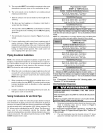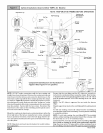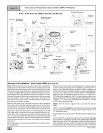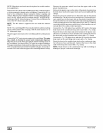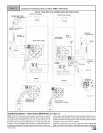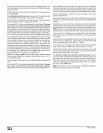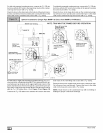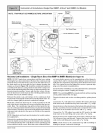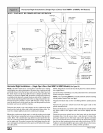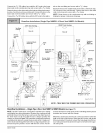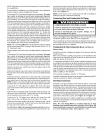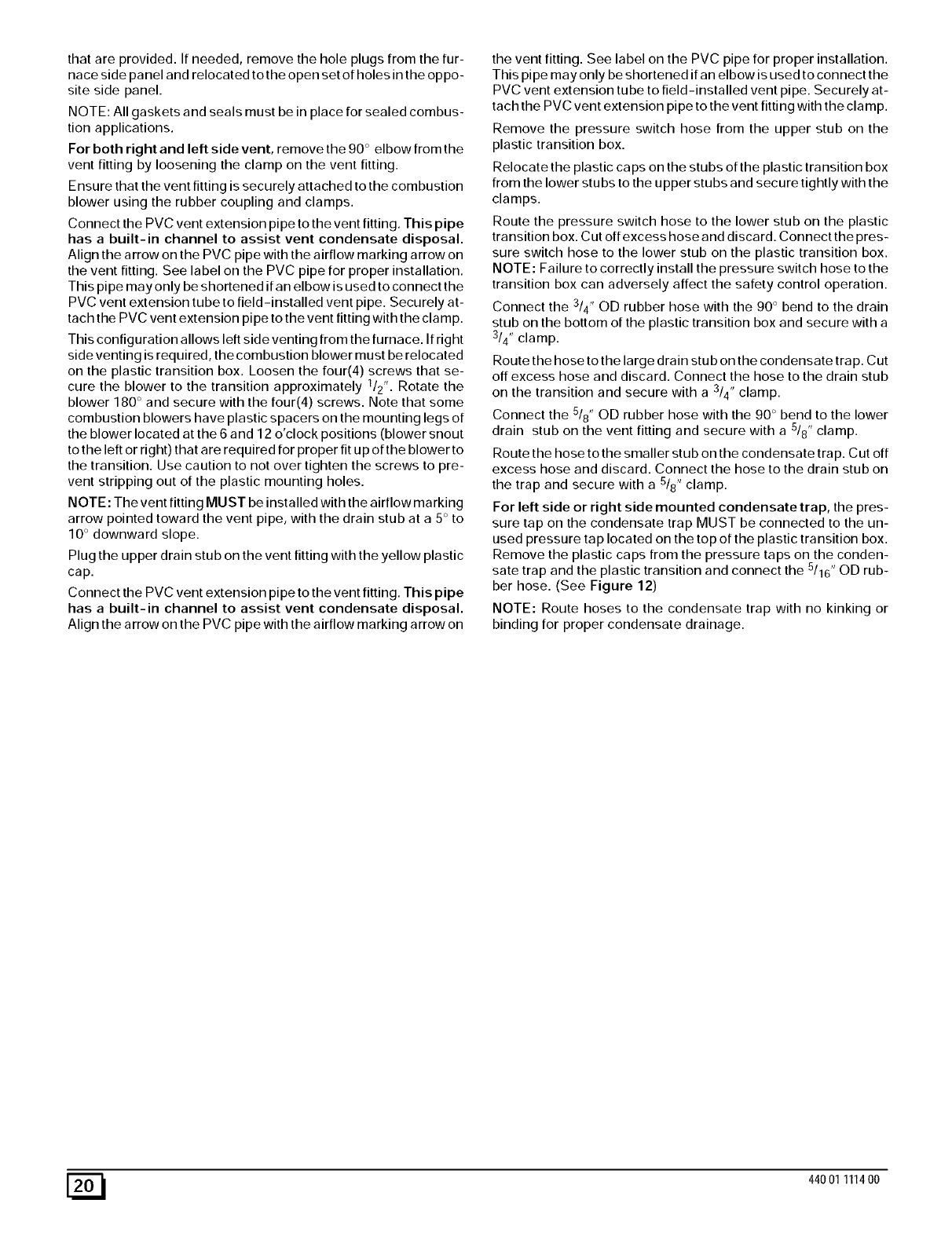
that are provided. If needed, remove the hole plugs from the fur-
nace side panel and relocated to the open set of holes in the oppo-
site side panel.
NOTE: All gaskets and seals must be in place for sealed combus-
tion applications.
For both right and left side vent, remove the 90 ° elbow from the
vent fitting by loosening the clamp on the vent fitting.
Ensure that the vent fitting is securely attached to the combustion
blower using the rubber coupling and clamps.
Connect the PVC vent extension pipe to the vent fitting. This pipe
has a built-in channel to assist vent condensate disposal.
Align the arrow on the PVC pipe with the airflow marking arrow on
the vent fitting. See label on the PVC pipe for proper installation.
This pipe may only be shortened if an elbow is used to connect the
PVC vent extension tube to field-installed vent pipe. Securely at-
tach the PVC vent extension pipe to the vent fitting with the cla rap.
This configuration allows left side venting from the furnace. If right
side venting is required, the combustion blower must be relocated
on the plastic transition box. Loosen the four(4) screws that se-
cure the blower to the transition approximately 1/2". Rotate the
blower 180 ° and secure with the four(4) screws. Note that some
combustion blowers have plastic spacers on the mounting legs of
the blower located at the 6 and 12 o'clock positions (blower snout
tothe left or right) that are required for proper fit up of the blower to
the transition. Use caution to not over tighten the screws to pre-
vent stripping out of the plastic mounting holes.
NOTE: The vent fitting MUST be installed with the airflow marking
arrow pointed toward the vent pipe, with the drain stub at a 5° to
10 ° downward slope.
Plug the upper drain stub on the vent fitting with the yellow plastic
cap.
Connect the PVC vent extension pipe to the vent fitting. This pipe
has a built-in channel to assist vent condensate disposal.
Align the arrow on the PVC pipe with the airflow marking arrow on
the vent fitting. See label on the PVC pipe for proper installation.
This pipe may only be shortened if an elbow is used to connect the
PVC vent extension tube to field-installed vent pipe. Securely at-
tach the PVC vent extension pipe to the vent fitting with the clamp.
Remove the pressure switch hose from the upper stub on the
plastic transition box.
Relocate the plastic caps on the stubs of the plastic transition box
from the lower stubs to the upper stubs and secure tightly with the
clamps.
Route the pressure switch hose to the lower stub on the plastic
transition box. Cut off excess hose and discard. Connect the pres-
sure switch hose to the lower stub on the plastic transition box.
NOTE: Failure to correctly install the pressure switch hose to the
transition box can adversely affect the safety control operation.
Connect the 3/4" OU rubber hose with the 90 ° bend to the drain
stub on the bottom of the plastic transition box and secure with a
3/4" clamp.
Route the hose to the large drain stub on the condensate trap. Cut
off excess hose and discard. Connect the hose to the drain stub
on the transition and secure with a 3/4" clamp.
Connect the 518" OD rubber hose with the 90 ° bend to the lower
drain stub on the vent fitting and secure with a 518"clamp.
Route the hose to the smaller stub on the condensate trap. Cut off
excess hose and discard. Connect the hose to the drain stub on
the trap and secure with a 5/8" clamp.
For left side or right side mounted condensate trap, the pres-
sure tap on the condensate trap MUST be connected to the un-
used pressure tap located on the top of the plastic transition box.
Remove the plastic caps from the pressure taps on the conden-
sate trap and the plastic transition and connect the 5/16" OD rub-
ber hose. (See Figure 12)
NOTE: Route hoses to the condensate trap with no kinking or
binding for proper condensate drainage.
[_ 44001 111400



